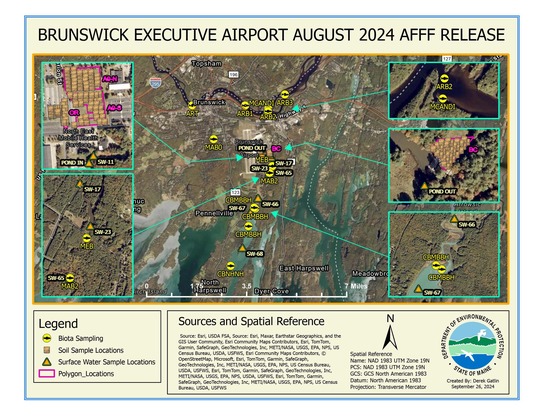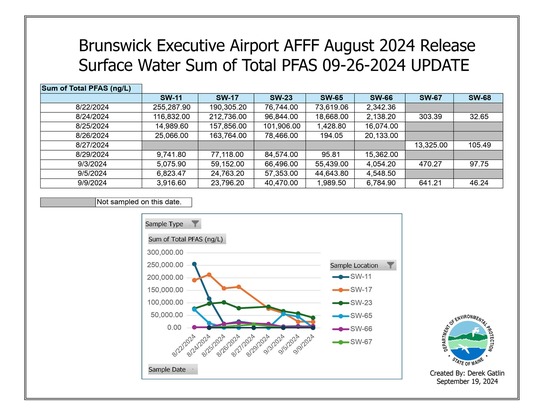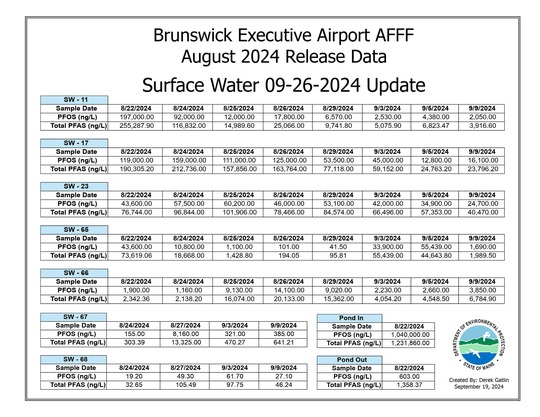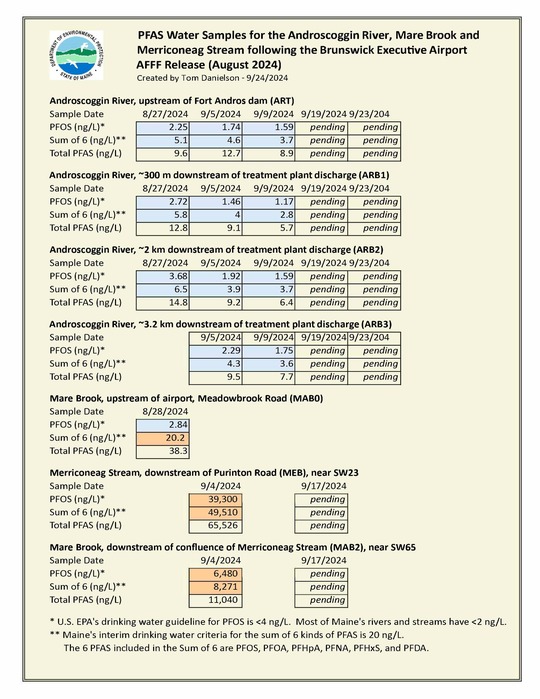Update 11: DEP continues to evaluate Brunswick's soil and water sample results
AUGUSTA, MAINE, September 26, 2024 — The Maine Department of Environmental Protection (DEP) sampled 34 water supplies for PFAS in the identified target area along Coombs Road, and the Department is in receipt of most of the analysis results. Property owners have been contacted by Department personnel to discuss their results, and they will be provided copies of the laboratory testing report. All samples analyzed to date are below the Maine Interim Drinking Water Guideline of 20 parts per trillion (same as nanograms per liter or ng/L) for the Sum of Six PFAS (PFOS + PFOA + PFHpA + PFNA + PFHxS, + PFDA). These same water supplies will be tested by the DEP every three months for one year. The next round of testing for these water supplies is planned for December 2024.
Department staff have evaluated eight rounds of surface water results collected from the Merriconeag Stream watershed documenting conditions following the AFFF release that occurred on August 19, 2024. Most concentrations continue to decline throughout the watershed, and the highest concentrations are still being detected below the Picnic Pond outflow. Four rounds of data from Harpswell Cove have been received by the Department and indicate contamination has reached the marine environment but is quickly being diluted to low concentrations. PFAS levels in the watershed have not yet returned to pre-spill concentrations and testing of surface water will continue to track the trends.
Soil results have been received from four areas that were identified as either the most likely to be impacted from the AFFF release or those with the greatest risk for potential exposure to recreational users. They include the soils adjacent to Hangar Four and immediately around the oil water separator, the field north of the outdoor athletic complex, soils surrounding the outdoor athletic complex, and the field southeast of Pond B where appreciable amounts of wind-blown foam accumulated on the day of the AFFF release. Preliminary review of the analytical results identified some PFAS detections in all area soils that were tested. Soil concentrations at the Hanger Four area and athletic complex were only slightly above background soil levels for urban developed soils and were well below the States Remedial Action Guidelines for a park user exposure scenarios (see the PFAS Soil Remedial Action Guidelines in the Maine PFAS Screening Levels Document). The field southeast of Pond B where appreciable amounts of wind-blown foam accumulated on the day of the AFFF release was found to have the soil concentrations of PFAS well above background levels but still lower than the States Remedial Action Guidelines for the park user exposure scenario. This field is owned by the Navy and is posted with no trespassing signs. A comprehensive evaluation of the soil testing results by the Department and its partner agencies is ongoing.
    DEP personnel also sampled four locations on the Androscoggin River in Topsham and Brunswick, following the release of AFFF at the Brunswick Executive Airport. There was concern that PFAS from the spill made its way to the Brunswick wastewater treatment plant (Brunswick Sewer District) and was discharged to the Androscoggin River. Sample results from the Brunswick Sewer District are pending. An upstream control site (ART) was established upstream of the Fort Andros dam and approximately 3.2 km upstream of the discharge. Three sites were established downstream of the discharge, including ARB 1 (~300m downstream of the discharge), ARB2 (~2 km downstream of the discharge), and ARB3 (~3.2 km downstream of the discharge). ARB3 is also downstream of a small stream the drains the north side of the airport and former navy base. The Department also sampled two smaller streams on the south side of the base that were impacted by the AFFF spill. Merriconeag Stream was sampled at one location (MEB), downstream of Picnic Pond and Purinton Road. Merriconeag Stream eventually joins the larger Mare Brook. An upstream control site on Mare Brook (MAB0) was established at Meadowbrook Road and a downstream site was established below the confluence of Mare Brook and Merriconeag Stream (MAB2).
 The primary kind of PFAS associated with the AFFF spill is perfluorooctanesulfonic acid (PFOS). Most rivers and streams in remote parts of the Maine have <1 ng/L (parts per trillion, ppt) of PFOS in the water. In contrast, rivers and streams in more densely populated areas of Maine near landfills, wastewater treatment plants, airports, and agricultural fields with historic spreading of PFAS contaminated biosolids typically have <5 ng/L of PFOS in the water. PFOS samples from all four sites on the Androscoggin River (ART, ARB1, ARB2, and ARB3) had <4 ng/L of PFOS. The upstream site on Mare Brook (MAB0) had 2.84 ng/L of PFOS on 8/28. In contrast, Merriconeag Stream (MEB) had 39,300 ng/L of PFOS on 9/4. The downstream site on Mare Brook (MAB2) had a lower concentration than MEB but still had 6,480 ng/L of PFOS on 9/4. U.S. EPA recently established a standard of 4 ng/L of PFOS for drinking water. All of the samples from the Androscoggin River and the upstream site on Mare Brook (MAB0) had concentrations of <4 ng/L of PFOS.
Fish and shellfish tissue samples inherently take longer to process than water samples. Processing tissue samples requires additional challenging steps, including homogenizing, subsampling, and extracting PFAS from tissue and putting the PFAS in a liquid. In addition, there are fewer labs capable of analyzing fish and shellfish samples compared to the number of labs capable of analyzing water samples. The combination of a more complicated laboratory protocol for tissue samples and a shortage of labs capable of analyzing fish and shellfish samples has resulted in a turn-around time of several months for processing fish and shellfish samples.
The rain that fell today is the first significant precipitation event that has occurred since the August AFFF spill. Increased site inspections were carried out as a result, and no foam was observed or collected at any of the preestablished points. Tomorrow, a second site inspection is planned as a precaution.
The last of the PFAS-impacted water which has been stored in frac tanks near Hanger 4 has been completely removed. Approximately 30,000 gallons of impacted water was collected and transported out of state.
The Town of Brunswick and Midcoast Regional Redevelopment Authority (MRRA) have collaborated to add an opt-in notification list through the Town’s Notify Me® service. The “Brunswick Landing/MRRA” notification list will provide information, news, and alerts supplied by MRRA to subscribers via email and/or text message.
To sign up for this notification service, please visit the Town’s website (www.brunswickme.gov) and click on the Notify Me® link.
Brunswick Landing receives its public drinking water supply from the Brunswick-Topsham Water District (BTWD), and has been confirmed safe to drink. The public water supply has not been impacted by this incident. Homes and businesses served by the BTWD can safely use the water.
The Maine CDC advises the public to exercise caution and abstain from any recreational activities (such as swimming, boating, and wading) that may come into contact with the foam or waters until the possible effects of the AFFF release on waterbodies in the vicinity have been thoroughly evaluated.
The next update will be issued as soon as additional test results become available.
For additional information, contact:
David R. Madore, Deputy Commissioner
|